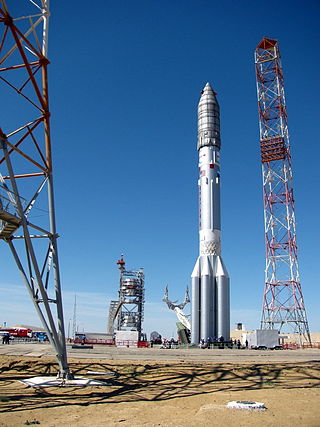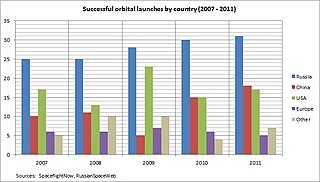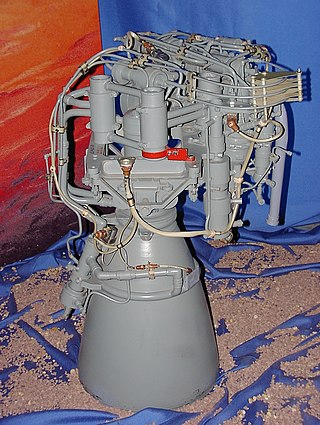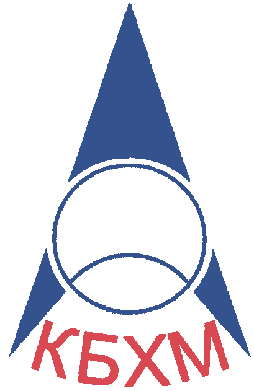Related Research Articles

Proton is an expendable launch system used for both commercial and Russian government space launches. The first Proton rocket was launched in 1965. Modern versions of the launch system are still in use as of 2023, making it one of the most successful heavy boosters in the history of spaceflight. The components of all Protons are manufactured in the Khrunichev State Research and Production Space Center factory in Moscow and Chemical Automatics Design Bureau in Voronezh, then transported to the Baikonur Cosmodrome, where they are assembled at Site 91 to form the launch vehicle. Following payload integration, the rocket is then brought to the launch pad horizontally by rail, and raised into vertical position for launch.

The Angara rocket family is a family of launch vehicles being developed by the Moscow-based Khrunichev State Research and Production Space Center. The launch vehicles are to put between 3,800 kg (8,400 lb) and 24,500 kg (54,000 lb) into low Earth orbit and are intended, along with Soyuz-2 variants, to replace several existing launch vehicles.

Rokot, also transliterated Rockot, was a Soviet Union space launch vehicle that was capable of launching a payload of 1,950 kilograms (4,300 lb) into a 200-kilometre (120 mi) Earth orbit with 63° inclination. It was based on the UR-100N intercontinental ballistic missile (ICBM), supplied and operated by Khrunichev State Research and Production Space Center. The first launches started in the 1990s from Baikonur Cosmodrome out of a silo. Later commercial launches commenced from Plesetsk Cosmodrome using a launch ramp specially rebuilt from one for the Kosmos-3M launch vehicle. The cost of the launcher itself was about US$15 million in 1999; The contract with European Space Agency (ESA) for launching Swarm in September 2013 was worth €27.1 million.

The Khrunichev State Research and Production Space Center is a Moscow-based manufacturer of spacecraft and space-launch systems, including the Proton and Rokot rockets, and the Russian modules of Mir and the International Space Station.
The Briz-K, Briz-KM and Briz-M are Russian liquid-propellant rocket orbit insertion upper stages manufactured by Khrunichev State Research and Production Space Center and used on the Proton-M and Angara A5. The upper stages were also used on Rokot, one of Russia's smaller launchers, before its retirement in 2019.

The Proton-M, (Протон-М) GRAU index 8K82M or 8K82KM, is an expendable Russian heavy-lift launch vehicle derived from the Soviet-developed Proton. It is built by Khrunichev, and launched from sites 81 and 200 at the Baikonur Cosmodrome in Kazakhstan. Commercial launches are marketed by International Launch Services (ILS), and generally use Site 200/39. The first Proton-M launch occurred on 7 April 2001.

The Proton-K, also designated Proton 8K82K after its GRAU index or SL-12 after its model number, 8K82K, was a Russian, previously Soviet, carrier rocket derived from the earlier Proton. It was built by Khrunichev, and launched from sites 81 and 200 at the Baikonur Cosmodrome in Kazakhstan.

Russia's space industry comprises more than 100 companies and employs 250,000 people. Most of the companies are descendants of Soviet design bureaux and state production companies. The industry entered a deep crisis following the dissolution of the Soviet Union, with its fullest effect occurring in the last years of the 1990s. Funding of the space program declined by 80% and the industry lost a large part of its work force before recovery began in the early 2000s. Many companies survived by creating joint-ventures with foreign firms and marketing their products abroad.
Globus-1M #12L or No.12L, also known as Raduga-1M 2 is a Russian military communications satellite which is operated by the Russian Space Forces. It was the second Raduga-1M satellite to be launched – the first being Globus-1M #11L which was launched in 2008, and forms part of the Raduga satellite system. It is positioned in geostationary orbit at a longitude of 70 degrees East.
SERVIS-2, or Space Environment Reliability Verification Integrated System 2, is a Japanese technological research satellite which was launched in 2010. It was constructed by Mitsubishi Electric, and will be operated by the Institute for Unmanned Space Experiment Free Flyer, USEF. It follows on from the SERVIS-1 spacecraft, which was launched in 2003.
Ekspress-MD2 is a Russian communications satellite which was lost due to a launch failure on 6 August 2012. Equipped with eight C-band transponders and 1 L-band transponder, it was intended to be located in geostationary orbit at a longitude of 145° East. It was the second Ekspress-MD satellite to be launched, following Ekspress-MD1 in 2009.
Telkom-3 is an Indonesian communications satellite which failed to reach its target orbit due to a launch failure on 6 August 2012. It was built by ISS Reshetnev for Indonesian telecommunications provider PT Telekomunikasi Indonesia. It was based on the Ekspress-1000H bus and had 32 C band transponders and 16 Ku-band transponders. It was due to be located in geosynchronous orbit at 118° East above the equator. The satellite reentered the atmosphere and was destroyed on 5 February 2021.

Luch 5B is a Russian Luch relay satellite which transmits data from the Russian Orbital Segment of the International Space Station, and from other satellites in low Earth orbit. It is in geosynchronous orbit.

The S5.92 is a Russian rocket engine, currently used on the Fregat upper stage.
The RD-0236 (GRAU Index 15D114) is a liquid rocket vernier engine, burning N2O4 and UDMH in the gas generator cycle. It is used along the RD-0235 main engine on the UTTKh second stage, which was featured in the UR-100N ICBM as well as the Strela and Rokot launch vehicles derived from it. Its function is to supply thrust vector control by gimbaling each of its four nozzles in a plane. While the engine is out of production, the ICBM as well as Strela remain operational as of 2015. The Rokot launch vehicle conducted its final launch before retirement in December 2019.
Voronezh Mechanical Plant is a Russian engine and heavy machinery manufacturing plant. It is located in the city of Voronezh, in the Voronezh Oblast.
The S5.80 is a liquid pressure-fed rocket engine burning N2O4/UDMH with an O/F of 1.85. It is used for crew-rated spacecraft propulsion applications. It is currently used in the Soyuz-TMA-M spacecraft propulsion module KTDU-80, and its sibling, the S5.79 rocket engine, is still used as the main propulsion of the Zvezda ISS module. The S5.80 generates 2.95 kN (660 lbf) of thrust with a chamber pressure of 0.88 MPa (128 psi) and a nozzle expansion of 153.8 that enables it to achieve a specific impulse of 302 s (2.96 km/s). It is rated for 30 starts with a total firing time of 890 seconds. The engine, without the pressurization system or propellant tanks, weighs 310 kg (680 lb) and is an integrated unit that is 1.2 m (47 in) long with a diameter of 2.1 m (83 in).

The A.M. Isayev Chemical Engineering Design Bureau, also known as KB KhimMash or just KBKhM, is a Russian rocket engine design and manufacturing company. It is located in the city of Korolyov. It started as the OKB-2 division of the NII-88 research institute, where A.Isaev directed the development of liquid rocket engines for ballistic missile submarines.
The S5.142 (AKA DST-25) is a liquid pressure-fed rocket engine burning N2O4/UDMH with an O/F of 1.85. It is used for crew-rated spacecraft propulsion applications. It was used in KTDU-80 propulsion module from the Soyuz-TM to the Soyuz-TMA-M, as the low thrust thruster (DPO-M). As of the Soyuz MS, KTDU-80 does not use DPO-M anymore.
Ekspress-MD1, was a Russian geostationary communications satellite operated by Russian Satellite Communications Company (RSCC) and designed and manufactured by Khrunichev State Research and Production Space Center on the Yakhta satellite bus for RSCC's Ekspress series. It massed 1,140 kg (2,510 lb) at launch, had a power production capacity of 1300 watts with a C-band and L-band payload.
References
- 1 2 Rockot User's Guide (PDF). EUROCKOT Launch Services GmbH. April 2011. Retrieved 2015-09-03.
- 1 2 Zak, Anatoly (2014-11-06). "Briz upper stage". RussianSpaceWeb.com. Retrieved 2015-09-03.
- 1 2 "КБХМ им.А.М.Исаева - Двигатель 14Д30. Разгонный блок "Бриз-М"" [Engine 14D30. The upper stage «Briz-M»]. kbhmisaeva.ru. KB KhIMMASH. Archived from the original on 23 April 2013.
- ↑ Kerbs, Gunter (2015-08-28). "Briz". skyrocket.de. Gunter's Space Page. Retrieved 2015-09-03.
- ↑ "Breeze M Upper Stage". khrunichev.ru. Khrunichev State Research and Production Space Center. Archived from the original on 3 June 2015.
- ↑ Brügge, Norbert. "Spacecraft-propulsion blocks from Isayev Design bureau (Khimmash)". b14643.de. Archived from the original on 2 June 2015. Retrieved 19 June 2015.
- ↑ "Конструкторское бюро химического машиностроения имени А.М.Исаева (КБХМ)" [Chemical Engineering Design Bureau name after A.M.Isaev (KBHM)]. lpre.de. Retrieved 22 June 2017.
